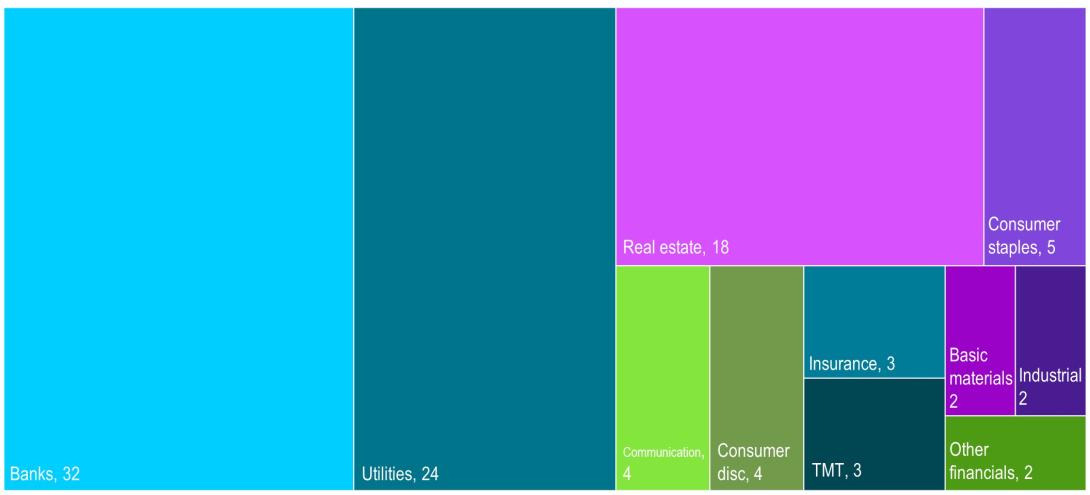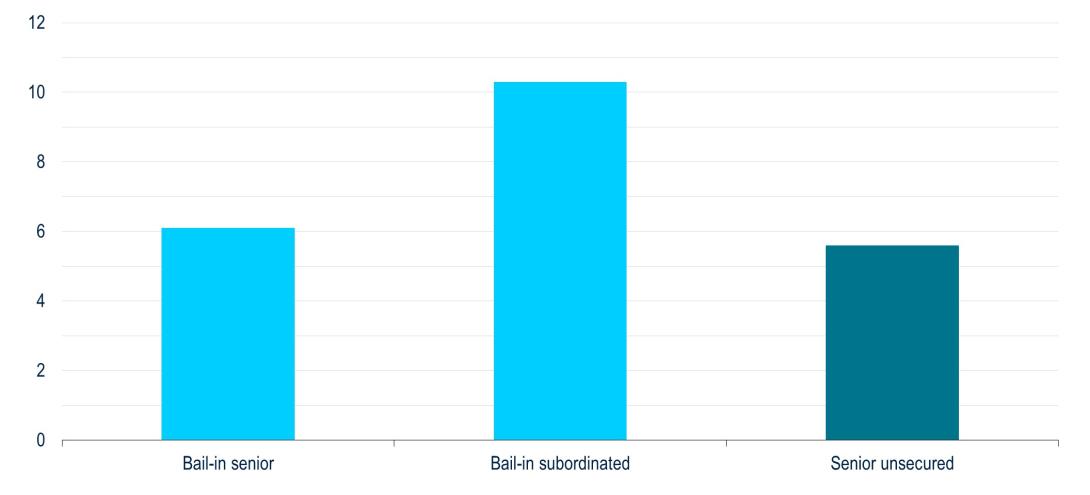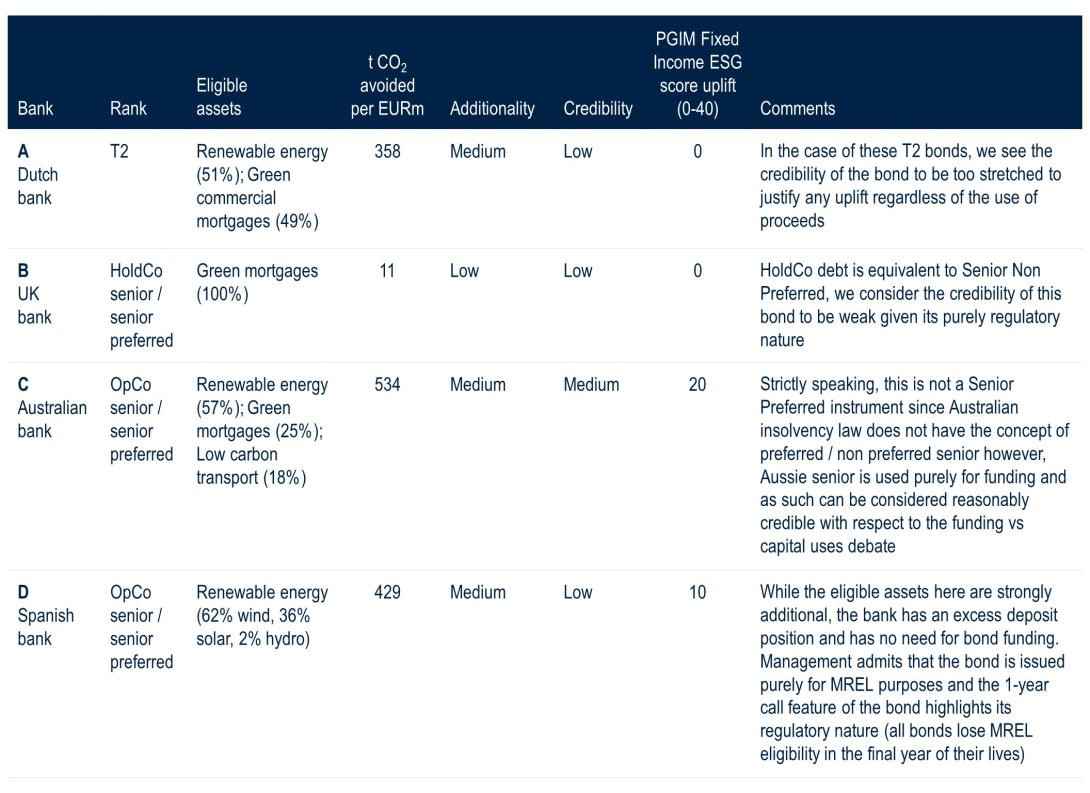Green Bank Bonds: Abuse of Proceeds?

Banks are the main issuers of Green, Social, and Sustainability (GSS) bonds, representing nearly a third of this $1.2 trillion market (Figure 1). But over half of banks’ GSS bonds are either subordinated, as senior non-preferred or holding company (“HoldCo”) senior unsecured debt, or consist of capital instruments, such as Tier 2 capital (“T2”) and Additional Tier 1 capital (“AT1”).
Banks mostly issue such subordinated bonds at the behest of regulators, and they can write them off in a crisis. That dilutes the argument that these bonds’ proceeds will be used for green or social purposes. We see three reasons why investors should treat such bonds’ claims to ESG eligibility with skepticism—see the conclusion for example results of our green bonds analysis.
Figure 1: Green, Social, and Sustainability bonds by sector in the Bloomberg Barclays Global Corporate Index (%)

Source: Bloomberg, as of 12 February 2023
GSS bonds issued for the purpose of regulatory requirements
Issuers of GSS bonds commit to investing their proceeds in projects or assets considered beneficial to the environment or society. In the banking sector, eligible uses of proceeds include loans to renewable energy projects, mortgages on sustainable houses, SME (small and medium-sized enterprise) loans, education or healthcare loans etc.
Yet, several banks have issued capital instruments, senior non-preferred, or senior HoldCo bonds (senior bail-in debt of this kind is intended for the bank to meet additional requirements on loss-absorbing capital) in the form of green or social bonds.
Some market participants argue that issuing green solvency capital and loss-absorbing debt shows commitment to ESG. In their eyes, doing so indicates willingness to have a green component in the permanent capital structure of the institution, rather than simply using it for operational, day-to-day funding.
We strongly disagree. In our view, the issuance of solvency capital instruments and, to a lesser extent, senior bail-in debt with green labels is more often than not misleading for investors for three reasons:
1. Banks use GSS bonds to support non-GSS assets.
2. If GSS bonds are bailed in, the equity capital they provide can finance non-GSS assets.
3. GSS bond maturities may not match the maturities of GSS assets.
1. Banks use GSS bonds to support non-GSS assets
Originally, banks issued green bonds as senior unsecured funding instruments: a €250 million bond issue would allow a bank to provide €250 million of qualifying green or social loans.
However, solvency and loss-absorbing debt does more than provide cash to be lent on: its primary purpose is to meet regulatory requirements. Such requirements apply to the whole bank, not just a green sub-section.
Most banks are subject to capital requirements expressed as a ratio of capital to risk-weighted assets (“RWA”)— a measure that adjusts loans and other assets for their relative credit risk with riskier assets receiving a higher weighting.
For example, if a bank had a T2 capital requirement of 2% and risk-weighted assets of €10 billion, its total T2 capital need would be €200 million. Issuing a €250 million T2 bond would more than cover the bank’s entire need for regulatory capital—well in excess of the funding provided by the bond.
But issuing this T2 bond as a green bond is misleading, because the benefit to the bank is much wider than the €250 million allocated to the green bond pool. For this green bond to be credible, the bank’s entire €10 billion risk-weighted asset base—including all of its loans—would have to be green or social.
Put another way, every euro of T2 capital that investors lend to the bank facilitates more than one euro of lending—not all of which is green.
2. If GSS bonds are bailed in, the equity capital they provide can finance non-GSS assets
Solvency capital and bail-in debt are designed to absorb losses and recapitalize banks without interrupting their normal course of business. This raises questions about the credibility of a green bond explicitly linked to a particular pool of assets.
The criteria used to trigger bank bond write-downs are based on group-level factors. Regulators have been clear that there must be no link between the performance of eligible assets and the capital functions of the bond raised to finance those assets.
In other words, if losses in the bank were large enough to trigger a write-down, the GSS bonds would also be written down, even if the GSS asset portfolio was performing well. This risk appears well understood by most GSS bond investors, but we view it as at odds with the principle of a use-of-proceeds bond.
To add insult to injury, in case of a green bond write-down, bondholders might be left holding equity in the bank. Equity, by its nature, isn’t applied to one, ring-fenced part of a company. As a result, GSS bond investors would own a share of non-eligible assets not even loosely linked to the original, eligible portfolio of green or social assets.
3. GSS bond maturities may not match the maturities of GSS assets
AT1 and T2 bonds are typically callable as increasingly are senior bail-in instruments. So, the maturity profile of GSS capital instruments is very different from other GSS bonds issued by banks, which typically have maturities between 5 and 7 years (Figure 2).
Figure 2: Average maturity at issuance of bank GSS bonds (years)

Source: Bloomberg, as of 15 February 2023.
Most capital instruments are issued with the expectation that they will be called at the first opportunity. However, if spreads widen significantly, issuers may choose not to call, for example because the cost of refinancing the outstanding bond is too high (A Fresh Approach to Analyzing Bank Capital Bonds). This is known as extension risk and introduces uncertainty around the eligible portfolio.
The eligible asset pool may contain assets of sufficient maturity to fulfil the criteria over the life of a 5-year bond but not over a 10-year period.
Investors need to assess the risk that an unexpected extension leads to possible future breaches of terms.
Conclusion: how does our approach affect our management of ESG portfolios?
At PGIM Fixed Income, we assign ESG Impact Ratings at the issuer level, which represent the total impact that the issuer has on the environment and society. However, we can uplift those ratings for individual or program GSS issues that we deem especially impactful. We do so by scoring use-of-proceeds bonds on their credibility and on the additionality of their proceeds to improving the environment or society.
Based on the concerns we outlined, our base case assumption for bank solvency and bail-in senior capital is that neither has sufficient credibility. Sometimes, we give limited credit for additionality, including exceptions for bail-in bonds (rather than capital instruments) with particularly positive eligible assets. Swiss banks, for example, only issue green bonds as senior non-bail-in debt, albeit primarily at the behest of the regulator.
Figure 3 shows our credibility and additionality assessments for selected bonds. The purely regulatory instruments of banks A and B receive a low credibility score. But the senior preferred debt of Banks C and D receives different credibility scores, based on whether that debt is primarily used for funding or regulatory purposes.
Figure 3: Some Green Bonds Have More ESG Impact than Others

Source: PGIM Fixed Income. For illustrative purposes only. The above is not inclusive of all ESG potential issues and engagement. ESG ratings are subject to change without notice. Please see the Notice for additional disclosures.
Read More from PGIM Fixed Income
The comments, opinions, and estimates contained herein are based on and/or derived from publicly available information from sources that PGIM Fixed Income believes to be reliable. We do not guarantee the accuracy of such sources or information. This outlook, which is for informational purposes only, sets forth our views as of this date. The underlying assumptions and our views are subject to change. Past performance is not a guarantee or a reliable indicator of future results.
Source(s) of data (unless otherwise noted): PGIM Fixed Income, as of February 28, 2023
For Professional Investors only. Past performance is not a guarantee or a reliable indicator of future results and an investment could lose value. All investments involve risk, including the possible loss of capital.
PGIM Fixed Income operates primarily through PGIM, Inc., a registered investment adviser under the U.S. Investment Advisers Act of 1940, as amended, and a Prudential Financial, Inc. (“PFI”) company. Registration as a registered investment adviser does not imply a certain level or skill or training. PGIM Fixed Income is headquartered in Newark, New Jersey and also includes the following businesses globally: (i) the public fixed income unit within PGIM Limited, located in London; (ii) PGIM Netherlands B.V., located in Amsterdam; (iii) PGIM Japan Co., Ltd. (“PGIM Japan”), located in Tokyo; (iv) the public fixed income unit within PGIM (Hong Kong) Ltd. located in Hong Kong; and (v) the public fixed income unit within PGIM (Singapore) Pte. Ltd., located in Singapore (“PGIM Singapore”). PFI of the United States is not affiliated in any manner with Prudential plc, incorporated in the United Kingdom or with Prudential Assurance Company, a subsidiary of M&G plc, incorporated in the United Kingdom. Prudential, PGIM, their respective logos, and the Rock symbol are service marks of PFI and its related entities, registered in many jurisdictions worldwide.
These materials are for informational or educational purposes only. The information is not intended as investment advice and is not a recommendation about managing or investing assets. In providing these materials, PGIM is not acting as your fiduciary. PGIM Fixed Income as a general matter provides services to qualified institutions, financial intermediaries and institutional investors. Investors seeking information regarding their particular investment needs should contact their own financial professional.
These materials represent the views and opinions of the author(s) regarding the economic conditions, asset classes, securities, issuers or financial instruments referenced herein. Distribution of this information to any person other than the person to whom it was originally delivered and to such person’s advisers is unauthorized, and any reproduction of these materials, in whole or in part, or the divulgence of any of the contents hereof, without prior consent of PGIM Fixed Income is prohibited. Certain information contained herein has been obtained from sources that PGIM Fixed Income believes to be reliable as of the date presented; however, PGIM Fixed Income cannot guarantee the accuracy of such information, assure its completeness, or warrant such information will not be changed. The information contained herein is current as of the date of issuance (or such earlier date as referenced herein) and is subject to change without notice. PGIM Fixed Income has no obligation to update any or all of such information; nor do we make any express or implied warranties or representations as to the completeness or accuracy.
Any forecasts, estimates and certain information contained herein are based upon proprietary research and should not be interpreted as investment advice, as an offer or solicitation, nor as the purchase or sale of any financial instrument. Forecasts and estimates have certain inherent limitations, and unlike an actual performance record, do not reflect actual trading, liquidity constraints, fee. These materials are not intended as an offer or solicitation with respect to the purchase or sale of any security or other financial instrument or any investment management services and should not be used as the basis for any investment decision. PGIM Fixed Income and its affiliates may make investment decisions that are inconsistent with the recommendations or views expressed herein, including for proprietary accounts of PGIM Fixed Income or its affiliates.
Investing in the bond market is subject to risks, including market, interest rate, issuer, credit, inflation risk, and liquidity risk. The value of most bonds and bond strategies are impacted by changes in interest rates. Bonds and bond strategies with longer durations tend to be more sensitive and volatile than those with shorter durations; bond prices generally fall as interest rates rise, and low interest rate environments increase this risk. Reductions in bond counterparty capacity may contribute to decreased market liquidity and increased price volatility. Bond investments may be worth more or less than the original cost when redeemed. Mortgage- and asset-backed securities may be sensitive to changes in interest rates, subject to early repayment risk, and while generally supported by a government, government agency or private guarantor, there is no assurance that the guarantor will meet its obligations. High yield, lower-rated securities involve greater risk than higher-rated securities; portfolios that invest in them may be subject to greater levels of credit and liquidity risk than portfolios that do not. Investing in foreign-denominated and/or -domiciled securities may involve heightened risk due to currency fluctuations, and economic and political risks, which may be enhanced in emerging markets. Currency rates may fluctuate significantly over short periods of time and may reduce the returns of a portfolio. Commodities contain heightened risk, including market, political, regulatory and natural conditions, and may not be suitable for all investors. Diversification does not ensure against loss.
In the United Kingdom, information is issued by PGIM Limited with registered office: Grand Buildings, 1-3 Strand, Trafalgar Square, London, WC2N 5HR. PGIM Limited is authorised and regulated by the Financial Conduct Authority (“FCA”) of the United Kingdom (Firm Reference Number 193418). In the European Economic Area (“EEA”), information is issued by PGIM Netherlands B.V., an entity authorised by the Autoriteit Financiële Markten (“AFM”) in the Netherlands and operating on the basis of a European passport. In certain EEA countries, information is, where permitted, presented by PGIM Limited in reliance of provisions, exemptions or licenses available to PGIM Limited under temporary permission arrangements following the exit of the United Kingdom from the European Union. These materials are issued by PGIM Limited and/or PGIM Netherlands B.V. to persons who are professional clients as defined under the rules of the FCA and/or to persons who are professional clients as defined in the relevant local implementation of Directive 2014/65/EU (MiFID II). In certain countries in Asia-Pacific, information is presented by PGIM (Singapore) Pte. Ltd., a Singapore investment manager registered with and licensed by the Monetary Authority of Singapore. In Japan, information is presented by PGIM Japan Co. Ltd., registered investment adviser with the Japanese Financial Services Agency. In South Korea, information is presented by PGIM, Inc., which is licensed to provide discretionary investment management services directly to South Korean investors. In Hong Kong, information is provided by PGIM (Hong Kong) Limited, a regulated entity with the Securities & Futures Commission in Hong Kong to professional investors as defined in Section 1 of Part 1 of Schedule 1 (paragraph (a) to (i) of the Securities and Futures Ordinance (Cap.571). In Australia, this information is presented by PGIM (Australia) Pty Ltd (“PGIM Australia”) for the general information of its “wholesale” customers (as defined in the Corporations Act 2001). PGIM Australia is a representative of PGIM Limited, which is exempt from the requirement to hold an Australian Financial Services License under the Australian Corporations Act 2001 in respect of financial services. PGIM Limited is exempt by virtue of its regulation by the FCA (Reg: 193418) under the laws of the United Kingdom and the application of ASIC Class Order 03/1099. The laws of the United Kingdom differ from Australian laws. In Canada, pursuant to the international adviser registration exemption in National Instrument 31-103, PGIM, Inc. is informing you that: (1) PGIM, Inc. is not registered in Canada and is advising you in reliance upon an exemption from the adviser registration requirement under National Instrument 31-103; (2) PGIM, Inc.’s jurisdiction of residence is New Jersey, U.S.A.; (3) there may be difficulty enforcing legal rights against PGIM, Inc. because it is resident outside of Canada and all or substantially all of its assets may be situated outside of Canada; and (4) the name and address of the agent for service of process of PGIM, Inc. in the applicable Provinces of Canada are as follows: in Québec: Borden Ladner Gervais LLP, 1000 de La Gauchetière Street West, Suite 900 Montréal, QC H3B 5H4; in British Columbia: Borden Ladner Gervais LLP, 1200 Waterfront Centre, 200 Burrard Street, Vancouver, BC V7X 1T2; in Ontario: Borden Ladner Gervais LLP, 22 Adelaide Street West, Suite 3400, Toronto, ON M5H 4E3; in Nova Scotia: Cox & Palmer, Q.C., 1100 Purdy’s Wharf Tower One, 1959 Upper Water Street, P.O. Box 2380 - Stn Central RPO, Halifax, NS B3J 3E5; in Alberta: Borden Ladner Gervais LLP, 530 Third Avenue S.W., Calgary, AB T2P R3.
© 2023 PFI and its related entities.
2023-1989
Sign Up Now for Full Access to Articles and Podcasts!
Unlock full access to our vast content library by registering as an institutional investor .
Create an accountAlready have an account ? Sign in
